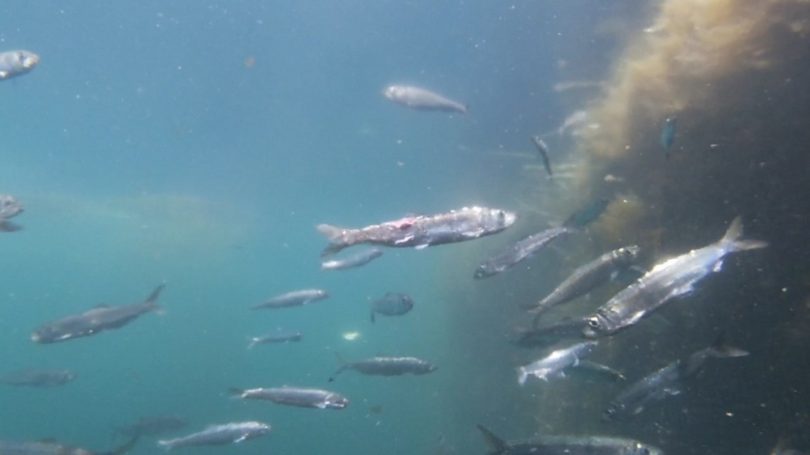Wild Salmon Recorded for First Time Inside Fish Farms
Published by Sea Shepherd Conservation Society
ƛaʔuukʷiʔatḥ / Tla-o-qui-aht First Nation members board salmon farms for the first time to inspect and document the impact of salmon aquaculture in their unceded waters, an area within the Clayoquot Sound UNESCO World Biosphere Reserve.
Clayoquot Sound, June 17th, 2019 – On June 11, 2019, members from the ƛaʔuukʷiʔatḥ / Tla-o-qui-aht First Nation, including Tribal Parks Guardians and members of the Clayoquot Sound Indigenous Salmon Alliance, boarded and inspected open net pen salmon farms in their territories for the first time. Supported by Sea Shepherd vessel Martin Sheen, Tla-o-qui-aht members deployed underwater cameras to document the state of the farmed salmon inside the pens.
Video footage revealed the presence of never before recorded juvenile wild salmon inside the open net pens. Wild herring and other wild fish species were also recorded as well as the presence of jaundiced, emaciated and deformed farmed fish.
The pens belong to Creative Salmon, a company producing farmed Chinook salmon, and are located near Warne Island within Clayoquot Sound, a UNESCO listed World Biosphere Reserve. The same farms have previously been studied by Dr. Kristi Miller, who confirmed the presence of Piscine Orthoreovirus, a virus from Norway that appears to cause the jaundice in Chinook salmon, which leads to organ failure and death.
Independent biologist Alexandra Morton, who was on board the Martin Sheen and reviewed footage from the day’s activities confirmed, “seeing the jaundice Chinook in the pens means the virus PRV is being released into wild salmon habitat and this is going to be part of the reason wild Chinook salmon in the region have mysteriously collapsed. It’s very concerning”.
The underwater cameras also filmed sea lice on the farm fish, something the industry denied was occurring. Sea lice breeding unnaturally on farm fish infect juvenile wild salmon, and cause death. Alarmingly high levels of sea-lice have been observed during the past few months on young wild salmon near fish farms across both coasts of Vancouver Island. Internal government emails reveal the sea-lice situation is out of control.

In a last-ditch effort, Cermaq, a nearby fish farm operator owned by Mitsubishi, has lodged a request to Health Canada for permission to use Lufenuron, a flea treatment for pets, in hopes to contain the outbreak. The drug inhibits formation of exoskeletons in insects, its effects on shell fish, humans and the wider ecosystem are unknown. The chemical is so toxic that fish treated with this chemical cannot be eaten for 350 days.
Joe Martin, a Tla-o-qui-aht Master Carver and Tribal Parks Guardian stated: “This place right here right where we are sitting, all the way up the inlet used to have sockeye jumping everywhere all along the water here. Because these farms have been here for about 30 years, we don’t see fish jumping here anymore, and I am here on this farm because of that.”
The boardings are part of an ongoing movement which has been gathering momentum on the B.C. coast since First Nations in another region of BC occupied Marine Harvest salmon farms for 280 days in 2017/18. Last week’s rally in Tofino dubbed “Salmon: Talking Circle and March for Action!” organized by Tla-o-qui-aht member Tsimka Martin, owner/operator of Tofino based T’ashii Paddle School, saw several hundred people take over the streets of Tofino in opposition to 30 years of devastation to the environment, since the installation of floating farm pens by salmon aquaculture corporations.
Sea Shepherd research vessel Martin Sheen is anchored in Tofino Harbour, conducting its fourth summer season of Operation Virus Hunter, as a platform to conduct research on the effects of salmon farms and in support of First Nations and their efforts to protect indigenous salmon.
Locky Maclean, Director of Marine Operations at Sea Shepherd stated: “Wild salmon and forage fish should be protected from the harmful effects caused by the disease, sea lice and chemicals leaching from these farms” adding “This area has been designated by UNESCO as having universal significance, the Canadian Government has a responsibility to ensure the water flowing through this Sound is clean and healthy, from the open ocean to the inlets and all the way up the rivers”. Concluding, “the only long-term solution is for fish farms to be removed from the environment they are polluting”.
Opposition to salmon farming has become global in recent years as people fight to protect the last wild salmon runs from extinction.
Read the full article at: https://seashepherd.org/2019/06/17/wild-salmon-recorded-for-first-time-inside-fish-farms/










